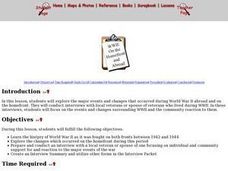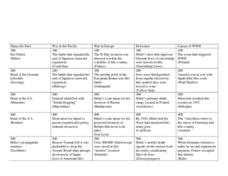Curated OER
Voyage of the St. Louis
Ninth graders explore the lives of Jewish refugees during WWII. After reading a brief passage about the people and the voyage of the St. Louis, 9th graders discuss how refugees have been treated historically. Reading and testing...
Curated OER
Navajo Code Talkers of WWII
Eighth graders assess different ways that significant individuals and events influenced economic, social and political systems in the United States after 1880. They experience a Navajo code talker's dictionary to create and decode messages.
Curated OER
Women Air Force Service Pilots
Tenth graders evaluate the contributions of female services pilots during World War II. They discuss the service of the women as well as the conditions they confronted. Students compare and contrast the treatment of male and female...
Curated OER
World War II
Students analyze primary sources (photographs) for evidence of American military technology during WWII. They debate the use of the Atomic Bomb. Students view the Rosenthal image. They discuss the image in detail.
Curated OER
Major people and events of WWII
Twelfth graders research major people from WWII. They interview each person in their group, then create a newspaper which contains articles, advertisements and illustrations from the WWWII period.
Curated OER
The Road to World War II
Middle schoolers research the orgins and early events of World War II using online and off line resources. They conduct an interview with a local World War II veteral and present their findings to the class.
Curated OER
Lost Peace
Pupils view a television program that chronicles the failure of the League of Nations as a deterrent to further war. They create a timeline of events that led from WWI to WWII and hold a mock town meeting in which they discuss the pros...
Curated OER
Uncle Sam Wants You!
High schoolers examine several narratives exploring attitudes to World War II involvement at the time. They develop their own opinions and write a fictional personal narrative to record their observations.
Curated OER
The Home Front - "Use It Up, Wear It Out, Make It Do Or Do Without!"
Students examine documents that explore U.S. government advertisements from the WWII era that encouraged people to grow victory gardens, recycle and conserve resources as part of the war effort. They discuss propaganda and design their...
Curated OER
Second World War - Conscription Events
Students explore the iam Lyon Mackenzie King Diaries which describe the involvement of Canada in WWII.
Curated OER
The Conscription Crises
Students explore roles played by Canada's prime ministers The Right Honorable Sir Wilfrid Laurier and The Right Honorable iam Lyon Mackenzie King with regards to the conscription crises of World War I and World War II.
Curated OER
Pearl Harbor vs September 11 Attack
Learners compare and contrast the events of the Pearl Harbor Attack and the attack on September 11, 2001 by examining the similarities and differences between these two events.
Curated OER
Dictator for the Day
Students experiment with being a dictator and sorting students into "desirable" and "undesirable" groups. They discuss freedoms and contrast U.S. government to dictatorships.
Curated OER
The Great Depression and World War II
In this Great Depression and World War II instructional activity, students fill in blank columns with information about scarce natural resources, human resources and capital resources, then write about what the US gave up when they sent...
Curated OER
Political and Social Impact of World War II
Sixth graders study the life in Jewish ghettos during World War II and learn about tolerance and compassion. In this WWII lesson, 6th graders discuss Jewish ghettos but with a mistreatment of the kids with stickers to signify the Jewish...
Curated OER
Origins of US Involvement in WWII
Fifth graders view several pictures obtained from a government website using the subtopic, "War" and listen to explanations of the origins of our involvement in wars in the past. They listen to lecture about why nations become involved...
Curated OER
Geographic Factors and Physical Environment
Sixth graders discuss WWII in their classroom. They take a field trip to the National Museum of the Pacific War. Each section of the museum has a comprehension question to go along with it. The Bougainville Campaign Exhibit asks students...
Curated OER
Atomic Bomb-Truman Press Release-August 6, 1945
Students read a copy of Truman's press release regarding the atomic bomb. They answer a series of factual questions regarding the press release. They discuss the press release and then follow up with answering more in depth questions...
Curated OER
Arkansas and the Dust Bowl
Students access and use the Farm Security Administration and Office of War Information, American Memory collection and Todd and Sonkin collection for research. They develop research skills and strategies, such as key word searches to...
Curated OER
Pearl Harbor
Students summarize reasons for the U.S. entrance into WWII. They evaluate the pros and cons of those reasons. Students constrict a time line of WWII events. They write in their journals: What role did emotions play in the U.S....
Curated OER
WWII: On The Homefront and Abroad
Students explore World War II from the perspective of both the sides. They research the changes that occurred on the homefront during 1942-1944. Students prepare and conduct an interview with a local veteran or spouse of a veteran...
Curated OER
Jeopardy Review for WWII
Students participate in a Jeopardy-style review game for a quiz on WWII. They divide into teams, choose team captains and answer a variety of questions pertaining to the study of WWII.
Curated OER
Attu Battlefield: U.S. Army and Navy Airfields on Attu
Students use maps, readings, drawings and photos to research the World War II Battle of Attu. They explain the importance of the battle, discuss the valor and loyalty of both American and Japanese troops and analyze sources of historical...
Curated OER
WWII and the Atomic Bomb
Students explore three decisions about the atomic bomb faced by the U.S. during WWII, take a position on each of the decisions, and defend their position. Should a bomb have been built, dropped, and was the right decision made?

























